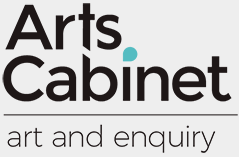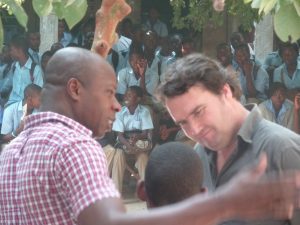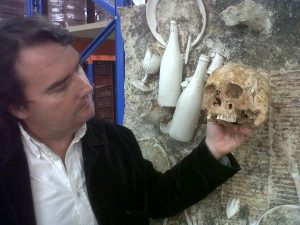Photo : Bernard Müller
Azé Kokovivina, The voodoo priest
Activation de l’autel de Kelessi, Exposition “Les maître du désordre”, Madrid, « La Caixa » Foundation (Madrid, Espagne) du 7 février au 19 mai 2013.
En arrière-plan : arrêt sur image de l’action Joseph Beuys : « comment expliquer les tableaux à un lièvre mort ?», 1965
The fieldwork as a convivial and undisciplinary practice
Interview with Bernard Müller, Anthropologist and Dramaturg
Annabelle Boissier
Bernard Müller is a researcher/lecturer in social anthropology (PhD 2000), dramaturg
and scientific/cultural programme designer. He is associate member of IRIS (EHESS, Paris) and Institut für Ethnologie, Universität Leipzig (Germany). Dedicated to the cultural history of West Africa (Nigeria, Benin Republic, Togo, Ghana), his research also extends to other territories, mainly Europe and Brazil and focuses on the relationship between art and ethnology today.
Bernard went through an ‘epistemic crisis’ in 1995 during his very first “field-work”, when the Lagosian (Nigeria) theatre director Makinde Adeniran invited him to change his role as scientific anthropologist to dramaturg of the very same play he was supposed to study. Since then, Bernard is constantly testing the link between research and art practices, in particular through his performance-based research group: CURIO [www.curioweb.org].
In this interview for Arts Cabinet, Bernard explores the uniqueness of an original practice, which goes beyond traditional research frameworks. Based on is personal experience, he provides an overview of situations that may lead researchers to open their practices to art and describes the obstacles they face inside the academy, their traditional space of action. In doing so, he defines the basis upon which a structure dedicated to art and research should stand.
Which Anthropology do you adhere to?
I’m part of a relatively marginal movement in anthropology which I would gladly call UNdisciplinary[1]. It stands at the disorganised junction between several disciplines in art and science: anthropology, visual arts, performance studies, theatre studies, and of course literature.
The idea is to enable artistic approaches to draw on social sciences and humanities tools (notably ethnography), and similarly enable academic approaches to use artistic dimensions (which can be literary, poetic or related to visual art performance). By performance we refer to a variety of staging processes, whether a true play, a performance in the visual arts or any other form of staging such as interventions, object theatre, routes, activations, museum installations/mediations, urban explorations, psychogeographic strolls, film productions, choreographies, musicals (operas), etc.
I seek to create the conditions for research in the social sciences and humanities that can be combined with, or even are, artistic explorations. My wish is to turn performance into a vehicle of research. It involves creating artistic situations that induce forms of knowledge. A knowledge that is ultimately about social relations, indeed social relations are also of great interest for many – not all – artists, as artistic production is often a result of ethnographic observation, an observation which is part of an action but not outside of it. This is obvious in theater or performance art such as Fluxus actions, and Joseph Beuys’s idea of “social sculpture[2]”, an art of conversation. I think the history of anthropology as a discipline is generous enough to embrace a variety of approaches.
I had always thought of the ethnographic fieldwork as a literary exercise, theatrical or artistic. Envisaging the classical fieldwork of the ethnologist as a creative constraint, why not – to tease a bit – in the manner of the pataphysician[3] exercises or of the oulipians[4]. Nevertheless, I was sincerely impressed by Lévi-Strauss’s texts because of their formality – they are beautiful, have a beautiful “style” and an aesthetic through their abstraction… if I may say. Indeed, a great deal of ethnological texts are fantastic! But I never accepted his methodology of data collecting, which made me uncomfortable. I refer back to these issues in “La tradition remise en jeu[5]”.
It will be during my repeated stays in Nigeria while conducting my Ph.D. between 1995 and 2000 that my approach changed radically, and I positioned myself ‘off-orbit’. It happened the day I became the dramaturg (in the Brechtian way) of my “informer” – it’s the way I learned to name my interlocutor during my fieldwork methodology lessons, a manner I abhor since then – of the play I undertook to study and of which he was the director. I was literally drawn into my object with no possibility to go backward. Fortunately, there is a multiplicity of ways to conduct anthropologic research outside academic norms nowadays, namely in the interstices or radically outside, but not necessarily in opposition to, as I was explaining.
Can you give us some examples of your practice?
One of my fieldworks sought to comprehend the motivation of the revival of a “Brazilian” cultural form in Lomé, South Togo, through theater play. In collaboration with the Azé Kokovivina Concert Band, who is a “concert party” company, a sort of popular theatre as cabaret can be, we associated a play and an ethnographic fieldwork. We believed that this ethnodramaturgic experience (to use Johannes Fabian terminology[6]) could help describe and understand the rise of a new cultural movement, from the Afro-Brazilian population in the maritime regions of the Guinea Gulf, in West Africa.
Photo : Gaétan Noussouglo
Azé Kokovina, The clown, Lomé, 2013
In another vein, the project “excavation of the snare-picture[7]” turned an artistic action held on 1983 by Daniel Spoerri into a fieldwork about an art world. It was still about playing with forms, “mistreating” them… not in any destructive way, but rather to reinvent, having in mind the necessity of “refunctioning[8]” ethnology as George Marcus put it. By form I mean the limits the disciplines give to themselves by opposing art and science for example. My proposition is to disseminate one anothers’ concerns and methodologies for experimentation, just “to see” what happens. The experimentation invites me in it, not through a pre-existing principle. I have the feeling that you cannot drain the reality, that anthropology’s function should not be to reduce the world, but rather to complicate it and make it accessible from several perspectives. Indeed, humans’ behaviours are not unambiguous. The researcher’s position is far from obvious, one foot inside, one foot outside.
In the last example, it is rather difficult to claim that the decision not to participate in the art work as an archaeological excavation, was initially planned by the artist. In the example of the project Zomayi in Togo, the ethnographical description joins the dramaturgic text – in the sense Brecht gives to it: the text of representation, the one that describes the scenic actions.
My “philosopher’s stone” consists of trying to give the ethnographical description the rank of a stylistic exercise raised to the level of art which treats itself as science. I totally assume its aporetic aspect, but it is not because it is impossible that it is not interesting, or even “heuristic” in anthropological enquiring.
Photo : Jean-Damien Fleury
Gaétan Noussouglo and Bernard Müller during a worskop of the Zomayi project, Lomé, 2013
What challenges do you encounter?
Because of its compartmentalised and transdisciplinary nature, along with its floating episteme – is it art? is it science? it is both simultaneously? or neither of them? –, this approach is logically ignored by both artistic and scientific institutions and cannot truly fit into any curricula not because it is not considered worth its while but because it is not manageable from a bureaucratic point of view.
One can easily imagine how confusing this blurring of methodological boundaries can be, and how it can place the one who is practising it in a disciplinary blind spot, but also – interestingly – into an institutional wasteland, outside all eligibility criteria and “publish or perish” intimidation.
This uncomfortable situation is very inspiring since it forces us to invent our own terms and conditions of practice, intellectually as well as financially. By operating at the level of the episteme, the researcher redesigns all relations and conditions of knowledge production. The status of this knowledge is altered at the very moment when one changes the condition and situation of its formulation or production. As if the traditional scientific paradigm inherited from natural science would intrinsically imply an uneven power relation, in which the researcher overlooks his “subjects”.
On the other hand, this floating position also has many shortcomings. This can explain the long time-frame of that sort of projects. They hold black and start again, sometimes they fall asleep accordingly to opportunities and the energy you’re ready to give. To stimulate and bring together artists and researchers sharing those ideas I created “a research group on and through performance” in the form of an NGO [www.curioweb.org].
If you are not part of the institution as it is today, can we then say you are an “independent”? In the same way that a curator is not inevitably affiliated to a specific institution. Does it open the door to rethink research?
I would say yes and no at the same time. It’s a crucial point that may lead to misunderstanding. I advocate for as much collaboration as possible with the institution, but equally, it means that I will not bend my words to fit in. We live in a democracy, and all the ways of thinking should be represented in all our institutions, isn’t it so? Indeed, I really think that experimental or “quirky” approaches should have their own place in the university. That’s what I stand for. Despite the fact that more and more researchers are using this approach, it is still far from finding traction in the academy. I do not see any conspiracy in it. There are many reasons for that, mainly linked to the way the academy structured itself through disciplines. Counter-examples exist, such as Performance Studies developed by Richard Schechner[9] in the end of the seventies/begin eighties, based on a multidisciplinary, radical and experimental principle very criticized since its beginnings for its “heterodox” character, as it is still today. The institutional itinerary from a theatre company to a university department, and the interdisciplinary dialogue that has arisen (probably thanks to this institutional confusion), is a model of its kind, although our days are different.
If I really feel this approach has its place in the academy, we must admit our times are not favorable to experimentation. Institutions are more concerned with their own survival, their efficiency, and less with their critical reassessment, constructive it may be. Because of the steamroller of the bureaucratic rationalisation, ideas became data and teachers suppliers of eligibility criteria. This maybe a bit exaggerated, but the atmosphere has changed and with the exception of some “zones to be defended” (Zone à Défendre)[10], universities tend to become factories, where excellency refers to what corporations would call productivity…
In that context too, operating modes are to be invented. I reiterate: I’m neither angry, nor frustrated with the university. I find lots of support in it, and I admire researchers who find a way to work in that context. Just like me, there are plenty of students and confirmed researchers that have similar approaches. At the heart of the academic institution, there exist, fortunately, many hideouts, niches of UNdisciplinarity, heterotopias of all kinds… they are more numerous and more spread than we may believe. Those ‘islands of doubt’ hopefully shoulder their actions with a clear conscience.
Photo : Gaétan Noussouglo
A scene of concert-party, Lomé, 2013
How did you become an anthropologist?
As far as I recall, my interest in anthropology started from a feeling of raw curiosity and a desire to understand life, human beings, etc. “There is a mystery” as Edgar Morin puts it[11]. At first, there was a necessity and that necessity was curiosity. As naïve as it may seem, I took
the word ‘anthropology’ in the literal sense.
Over time, I realised that the fictionalised and romantic image I endorsed was closer to Borges than to Lévi-Strauss. Anthropology was less of a science for me, and more of a literary genre. I would say some kind of speculation, a ‘free figure’ whose specificity is to choose a ‘fieldwork’ as a ‘play space’. I was reading essays intensively, as well as a lot of literature, among them Borges, Perec, Calvino, but also Brecht who was a kind of ethnologist for me. I was reading a great amount of theatre within my practice as a dramaturg and stage assistant. Thus, during the last thirty years, the research and the dramaturg in me constantly crossed paths. I helped theatre companies as a dramaturge, in the sense defined by Brecht, as “scientific advisor”. Shakespeare, Jarry, Marivaux or Wole Soyinka make clear for me how close theatre and ethnology were, sharing a same concern: understanding and enunciating the complexity of human behaviour and social situations.
What struck me about some anthropologists was their free thinking, and the way they state and confront ideas through diverse logics. By opening new perspectives, they allowed me to see my own life under a new perspective, more complex and rich. I believe an idea can change a life, by opening a new possibility. I’m part of those who believe in the power of words, spoken or written, where poetic energy joins political impetus. For where I stood, the ethnological fieldwork couldn’t be reduced to a data production machine reflecting disciplinary priorities, but rather be a form of life as Deleuze said: “existence not as subject, but as if it is a work of art, and this last stage is the “artist-thought”.[12]
Is your approach new?
I would not say new, but maybe forgotten. This approach anchors itself in an ancient didactic tradition, not far from the alternative pedagogy developed at the turn of the twentieth century, such as Maria Montessori, Augustin Freinet, Alexander Sutherland Neill and its ramification in the social sciences and humanities, especially at Black Mountain College (founded in North Carolina, 1933): John Andrew Rice, Theodore Dreier, Frederick Georgia, and Ralph Lounsbury, organised principles of education around John Dewey’s (1859-1952). This tradition, libertarian to some extent, view the research as an emancipation tool resulting from a collective interaction, not really as individual enrichment, and even less as a data producing machine on an industrial model. It focussed on research experience in its qualitative and ethic dimensions which works only if the approach is shared.
What would be an egalitarian research methodology in social anthropology nowadays? When the study of an artistic practice is at stake, how not to consider the disparity of power relationships, the selectivity of the criteria of the academic market or the standardisation inferred by the administrative orders? In an academic moment which grant so little heuristic value to experimentation in social sciences and humanities, because they value most the production of measurable data, how one can say that such a project is possible, realistic, or even desirable? The collaborative principal is the key, it sparks a chain reaction which revisits every steps of the object construction. It’s a form of political ecology as elaborated by André Gorz[13], himself inspired by Ivan Illich[14], and applied to anthropology. Truthfully, all this appears to me to be a highly topical concern.
Photo : Laurent Védrine
The author in front of a mold of a the snare picture, Paris
To be or not to be an anthropologist ?
What project are you working on today?
Regarding my current project, I would like to invite you all to participate at “La clairière” (The Clearing) an activity responding to the very stimulating experience of Vincennes University (1968-1986). You can follow the project on this site : http://curioweb.org/clairiere/ . This seminar-workshop proposes to initiate a critical reflection based on a mode of research in the social sciences and humanities which proceeds through artistic creation, and through performance (as defined above). As much attention will be paid to artistic projects that draw from the ethnographic toolkit as well as scientific projects that also assume an artistic dimension (whether literary, poetic or plastic arts). Whatever the degree of this rapprochement, these processes have in common to fuse the artistic and scientific processes during the construction of their object. These methods open a new horizon by making intelligible the facts of otherwise inaccessible societies, in a collaborative spirit and suggesting new modes of restitution. The red thread of this year’s workshop will be the creation of a show, performance or evocation that echoes the experience of the University of Vincennes, on the 30th anniversary of its closure. This action proposes to bring to light the history of this exceptional project, by the radicalism of the principles which it claimed and the utopia of the vision of the society which animated it, in a way which remains today strangely difficult to forget. Theoretical sessions will alternate with the interventions of participants, witnesses or critics of the micro-utopia of Vincennes and practical workshops will prepare the “performance” to be presented in June 2018.
By Annabelle Boissier, Emails, New York, Paris and Dresde, August 2017
[1] The notion already has a long history and bibliography, see for instance: Laurent Loty, « Pour l’indisciplinarité », The Interdisciplinary Century; Tensions and convergences in 18th-century Art, History and Literature, edited by Julia Douthwaite and Mary Vidal, Oxford, Studies on Voltaire and the Eighteenth Century 2005:04, Voltaire Foundation, 2005, pp. 245-259.
[2] Bernard Müller, “Le terrain comme théâtre anthropologique”, Communications, N°91, janvier 2013.
[3] ‘Pataphysics is a concept expressed by Jarry in a mock-scientific manner with undertones of spoofing and quackery, in his fictional book Exploits and Opinions of Dr. Faustroll, Pataphysician, in which Jarry riddles and toys with conventional concepts and interpretations of reality. Another attempt at a definition interprets ‘pataphysics as an idea that “the virtual or imaginary nature of things as glimpsed by the heightened vision of poetry or science or love can be seized and lived as real”. Jarry defines ‘pataphysics in a number of statements and examples, including that it is “the science of imaginary solutions, which symbolically attributes the properties of objects, described by their virtuality, to their lineaments”. A practitioner of ‘pataphysics is a pataphysician or a pataphysicist.
[4] Oulipo (French pronunciation: [ulipo], short for French: Ouvroir de littérature potentielle; roughly translated: “workshop of potential literature”) is a loose gathering of (mainly) French-speaking writers and mathematicians who seek to create works using constrained writing techniques. It was founded in 1960 by Raymond Queneau and François Le Lionnais. Other notable members have included novelists Georges Perec and Italo Calvino, poets Oskar Pastior, Jean Lescure and poet/mathematician Jacques Roubaud.
[5] Bernard Müller, La tradition remise en jeu, La Courneuve, Ed. Aux-Lieux-d’Être, 2006.
[6] “Much of what we can know or learn about a culture/society does not come in the form of answers to our questions, but as performances in which the ethnographer acts, as V. Turner once put it, as an “ethnodramaturg” or as a kind of producer or provider of occasions where significant communicative events happen”
Johannes Fabian, Theater and Anthropology, Theatricality and Culture Research in African Literatures – Volume 30, Number 4, Winter 1999, pp. 24-31.
[7] Daniel Spoerri gave the following definition: objects, which are found in randomly orderly or disorderly situations, are mounted on whatever they are found on (table, box, drawer, etc.) in the exact constellation they are found in(…). By declaring the result to be a tableau, the horizontal becomes vertical. For example: the leftovers of a meal are mounted on the table and the table is then hung on a wall (…)”. The invention of the “snare-picture” marks the beginning of Spoerri’s career as a visual artist. Snare-pictures were first exhibited at the “Festival d’art d’avantgarde”, in Paris, Nov.18 – Dec. 1960.
[8] See: George E. Marcus, Experimental forms for the expression of norms in the ethnography of the contemporary, University of California—Irvine, https://www.haujournal.org/index.php/hau/article/view/hau3.2.011/757
[9] See: Schechner, Richard. “Foreword: Fundamentals of Performance Studies”, Nathan Stucky and Cynthia Wimmer, eds., Teaching Performance Studies, Southern Illinois University Press, 2002 or Lois Weaver : “I think of Performance Studies…as a hide-out, an after school program for bad boys and girls, a safe house for those who can’t go by the rules. Performance Studies is not one-size fits all, but all sizes try to fit in. That is, if you can handle conflict, cope with ambiguity, navigate the incomprehensible, relish the rivalry. For both artists and academics it can be a place to see yourself reflected, challenged, codified, cracked up, over baked and served up…Isn’t that the point? To question. Is it fun? Is it fashion? Or is it food? Or just further education?”.
[10] In the French political context, Zone à Défendre is a neologism diverted by activists from the Designated development area (Zone d’aménagement différé) allowing authorities to exercise a pre-emptive right for public development planning.
[11] Edgar Morin, Connaissance/Ignorance/Mystère, Fayard, 2017.
[12] “L’existence non pas comme sujet, mais comme œuvre d’art, et ce dernier stade, c’est la pensée-artiste. ” Gilles Deleuze, “La vie comme œuvre d’art”, 1986, in Pourparlers 1972-1990, Paris, Edition de Minuit, 2003.
[13] André Gorz, Écologie et politique, Paris, Le Seuil “Points”, 1978 [1975].
[14] Ivan Illich, La convivialité, Paris, Seuil, 1973.




